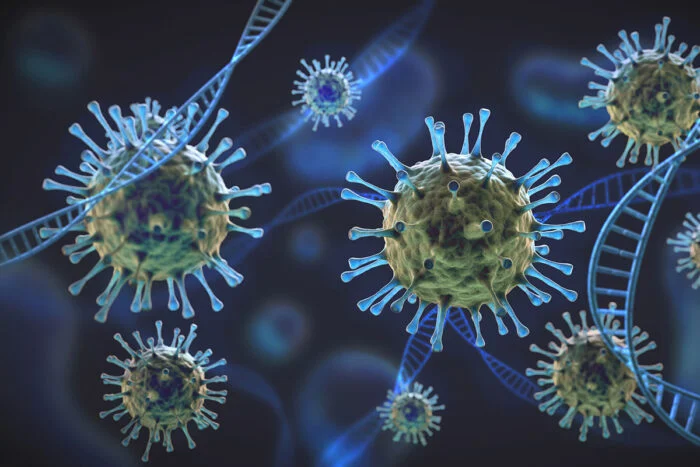Religion, Creationism, evolution, science and politics from a centre-left atheist humanist. The blog religious frauds tell lies about.
Friday, 30 September 2022
Creationism in Crisis - How the Precursors of Paired Fins and Limbs Evolved
There is little doubt now that the paired terrestrial tetrapod limbs, possessed by all terrestrial vertebrates, and those such as whales and turtles that he reverted to a marine existence, evolved out of the paired pectoral and pelvic fins of fish that first crawled onto land. The remaining question was how did these paired limbs evolve in the early fish? Because of gaps in the fossil record, it had looked as though fins suddenly appeared fully formed.
That question has now been answered by an international team, led by Min Zhu of the Institute of Vertebrate Palaeontology and Palaeoanthropology, Beijing and Professor Philip Donoghue from the University of Bristol’s School of Earth Sciences, whose discovery shows the primitive condition of paired fins before they separated into pectoral and pelvic fins, the forerunner to arms and legs.
The evidence was found in fossils in the rocks of Hunan Province and Chongqing and named Tujiaaspis after the indigenous Tujia people who live in this region. Unlike previous fossils records which are mostly just the heads, these fossils contain the whole body.
Earlier fossils either had fins or they didn't, with no fossil record of transition to paired fins. That gap has now been filled by Tujiaaspis. There had been a hypothesis that fins probably began as folds but is was just that - a hypothesis awaiting confirmation or falsification. That confirmation has now been provided.
As the press release from the University of Bristol explains:
Creationism in Crisis - Scientists Have Reconstructed the Genome of the Earliest Mammalian ancestor

via Wikimedia Commons
The creationist delusion that the Theory of Evolution is a theory in crisis, about to be replaced in mainstream biology with their childish, evidence free superstition based on the ludicrous idea that nothing evolves and everything is made by magic, took another blow today when an international team of scientists led by scientists from the University of California Davis and the Leibniz Institute for Zoo and Wildlife Research (Leibniz-IZW), Berlin, Germany, published their computed genome of the stem species from which all mammals evolved.
Such a project would not have been mooted had the scientists had the slightest doubt about evolution being the explanation for biodiversity, nor would it have been possible to compute this ancestral genome if the DNA of mammals did not form consistent hierarchy of nested clades resulting in evidence that the genomes of the ancestors of modern mammals form a family tree with a single origin, which lived about 200 million years ago.
The scientists' work is published in the scientific journal Proceedings of the National Academy of Sciences (PNAS).
As the scientists explain in the news release from Leibniz-IZW:
Wednesday, 28 September 2022
Malevolent Designer News - Yet Another SARS-CoV-2 Variant and Another Wave of COVID-19 is On The Way
According to this article in Science, another wave of COVID-19 infections is on the way because several different sub-strains of the Omicron variant have converged on a similar way to evade the antibodies our immune systems manufacture in response to vaccination and/or infection.
It's not possible to say which of the various emerging strains will come to predominate, but one variant, known as BA.2.75.2, is a likely candidate. It is proving to be especially successful at evading antibodies because changes at half a dozen key sites in its genome that affect the way antibodies bind to the spike proteins on the viral coat, mean the antibodies don't bind very successfully.
Tuesday, 27 September 2022
Creationism in Crisis - Scientists Show How Large Molecules Self-Assemble - No Gods Required Again

The recent rum of bad news for Creationism just got worse, with the news that scientists from the University of Massachusetts Amherst have discovered how large molecules such as proteins and DNA can self-assemble with nothing more than the laws of chemistry and physics. As always when one of Creationism's favourite gaps is snapped shut by science, no gods were found and the 'mystery' required nothing more than the operation of the natural laws of chemistry and physics.
In the words of one of the researchers:
The significance of the discovery that dipoles drive the assembly of polymers is immense because it throws new light on one of the fundamental mysteries of life’s processes, [how biological materials know how to self-assemble into coherent, stable structures]. The theory changes the paradigm of how we think about these systems, and highlights the unacknowledged role that dipoles play in the self-assembly of biological materials.
Professor Murugappan Muthukumar, senior author
Department of Polymer Science and Engineering, University of Massachusetts, Amherst, MA, USA
Monday, 26 September 2022
Malevolent Designer News - The Asian Longhorned Ticks Are Spreading Fast in USA
News today of another stunning triumph for Creationism's malevolent designer!
The Asian longhorned tick, Haemaphysalis longicornis is spreading fast in the USA. Worldwide is causes millions of dollars in lost revenue for cattle farmers. It was first reported in New Jersey in 2017 and has now spread to Missouri. The tick is responsible for spreading the organisms that cause bovine theileriosis, which is similar to anaplasmosis in that it causes weight loss, reduced milk yield and death in cattle. The longhorned tick is closely related to other ticks in the Haemaphysalis genus which are found extensively in Asia and Australasia, all of which can and do transmit bacterial and viral diseases.
I described in The Malevolent Designer: Why Nature's God is not Good how another tick, the black-legged tick, Ixodes scapularis transmits the disease anaplasmosis in humans by injecting the rickettsia bacterium, Anaplasma phagocytophilum when it bites.
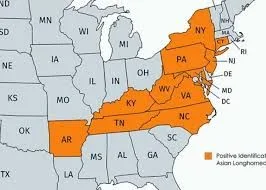
- Climate change, meaning the warmer temperatures in the US mid-west are creating a more conducive environment for it.
- the fact that females can breed parthenogenically, meaning they don't need to mate to produce thousands of fertile eggs - all of which are female with the same ability. This mean in a few years, a single female can quickly establish a very large population.
The University of Missouri news release explains the problem and how it was discovered:
Evolution News - How The Bird-Hipped Dinosaurs Evolved

First there was the news that plants have a ludicrously complex process for correcting the mistakes made when DNA is replicated, and how this shows common descent of plants and animals with the news that this process works when inserted into a human cell. Then there was yet more evidence of the malevolence of any creator who could come up with a design for a trypanosome flagellum that makes it easier for tsetse flies to inject it into us and cause sleeping sickness, and the news that a redesigned fungus is killing the frogs that would eat the mosquitoes that spread malaria. And lastly there is the news that the Theory of Evolution shows no signs of being abandoned as the best explanation for biodiversity but can even be applied to cultures with the finding that chimpanzees, like humans, form different cultural groups.
In fact, of course, most weeks are bad news weeks for Creationists because so many new scientific papers, especially in the fields of biology, archaeology and geology, refute Creationism without even trying, simply because, unlike Creationism, science is firmly grounded in observable and verifiable reality.
Now there is news that scientists from Cambridge University, UK, have shown how a group of dinosaurs, the remote ancestors of modern birds - the bird-hipped dinosaurs - evolved from a 'transitional', i.e., stem group, of dinosaurs, the silesaurs, which had been identified ten years earlier. They have published their finding in the Zoological Journal of the Linnean Society.
The Cambridge University News release explains how this discovery was made:
Saturday, 24 September 2022
Malevolent Designer News - How Creationism's Divine Malevolence Made Tsetse Flies to Pass on Sleeping Sickness

This news item should please devotees of Creationism's putative intelligent [sic] designer, if for no other reason than that it involves a flagellum. Those who fell for Michael J Behe's opening ploy in his intelligent design hoax were fooled into believing that a flagellum is an irreducibly complex structure so must have been designed by an intelligent designer because it could not have evolved by Darwinian gradual evolution.
Of course, Behe ignored the fact that the component parts of the flagellar proton motor pre-existed the flagellum, in the Type II Secretion System, which was a development of the proton pump, so all that was needed was for them to be exapted for a different function, and to give the organism an advantage. It also ignores the fact that there are lots of different flagella found in nature, some with even fewer components than those of E. coli, which he had claimed was the minimum necessary for a functional flagellum. Clearly, if other flagella can work with less components, that of E. Coli is not irreducibly complex
And, unwittingly, Behe gave us the idea of a malevolent designer, because E. coli is much better at making us sick because it has a flagellum, than it would be without it. Given that Creationists believe their putative designer is omniscient, it must have been aware of that when it designed the flagellum.
Anyway, no matter how comprehensively the hoax is refuted, or how malevolent it makes their favourite god look, Creationists will ignore the science and stick with the refuted notion, so those are the people who should be thrilled by this discovery. It is the discovery that the trypanosomes carried by the tsetse fly, which causes sleeping sickness in humans and debilitating diseases in cattle and horses, has a flagellum specially designed to enable the tsetse fly to pass it on in its saliva when it takes a blood meal.
Origins of the English
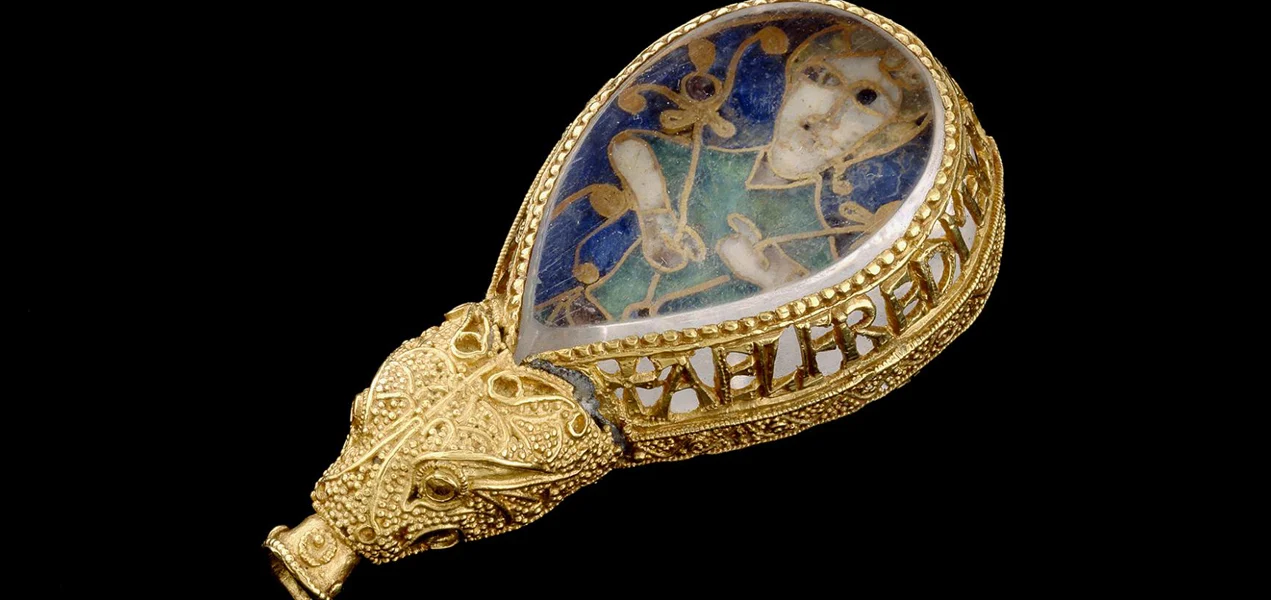
Believed to have been commissioned by King Alfred the Great and inscribed "AELFRED MEC HEHT GEWYRCAN" (Alfred me had made) in the West Saxon dialect.
The answer might surprise those little Englander nationalists who took us out of the European Union, as well as those on the far right who foster daft notions of English racial purity, because even in the Early Middle Ages, the average English person was actually only about 40% Anglo-Saxon, and even that proportion of the 'English' genome came from continental regions bordering the North Sea, including the Netherlands, Germany and Denmark. 20%-40% came from what is today Belgium and France. The rest is derived mostly from the indigenous population that was present at the time of the Roman occupation - Brythonic Welsh. The evidence is that the Germanic immigrants sometimes integrated and intermarried in some area, while in other places they formed which might have been an elite upper class.

That fact is confirmed by the work done by the Max Planck Institute and University of Central Lancashire, scientists.
Thursday, 22 September 2022
Cultural Evolution - In Chimpanzees

Archaeologist and primatologists from the Max Planck Institute for Evolutionary Anthropology, Leipzig, Germany, have discovered cultural differences between different groups of chimpanzees.
Ask any Creationist and they'll assure you that the fact that humans have developed art, music and architecture, to name just a few of our cultural developments, is evidence that there is something very special about humans, showing that we were specially created separate from the rest of 'creation' and given these 'gifts' to enable us to have 'dominion over the planet - which was provided for our benefit.
The problem with that argument from personal incredulity and wishful thinking, is that humans are far from being the only species to have cultures, albeit, our cultural developments of language and writing, combined with our ability to learn and recall facts, and to pass them on to our children, has enabled us to build on out innate ability to form cultural groups, to build advanced cultures. The difference is one of magnitude, not presence/absence. The analogy is with the elephant’s trunk, which is an example of variation on the same basic body plan, and so evidence of common ancestry, not special creation of elephants, although that analogy is probably too subtle for the simple binary thinking of Creationists.
The fact that our cultures have much in common with each other but vary considerably between different geographical groups is evidence of the evolutionary process involved in building those cultures. Sometimes, these cultural variations are very subtle, but most people who have been to other countries will be aware of them, especially with food, drink and language, and with little differences between driving behaviour, as I once showed with a blog post about the difference in driving customs between the UK and Naples, in Italy. What the scientists at the Max Planck Institute have discovered is that chimpanzees not only use stone tools as hammers to open nuts, but that the stone tool preferred varies between different social groups.
As the Max Planck Institute news release explains:
Malevolent Designer News - Creationism's Divine Malevolence is Killing the Frogs That Help Protect Us from Malaria
On the face of it, there is no connection between frogs and malaria, but scientists have discovered a correlation between the decline of frogs due to the fungus, Batrachochytrium dendrobatidis, and a spike in malaria cases in parts of Latin America, particularly in Costa Rica and Panama.
Readers may remember how I described the world-wide devastation of amphibian populations with the fungus, B. dendrobatidis (Bd), and how a team of researchers from the University of California at Davis had reported a link between these deaths and an increase in malaria, probably due to this removal from the ecosystem of major predators on mosquitos.
To be a Creationists is to believe this fungus, the effects it is having on global amphibian populations and the knock-on effects this is having on the ecosystem and human health, is the intended outcome of a supernatural intelligent [sic] designer, with this obviously malevolent intent.
Malevolent Designer News - God Doesn't Hate Frogs; He Just Loves Mosquitos and Malaria More.
The same UC Davis team has now reported a close correlation between the major die-off of amphibians in Costa Rica and Panama with a spike in malaria cases in the region. At the spike’s peak, up to 1 person per 1,000 annually contracted malaria that normally would not have had the amphibian die-off not occurred, the study found.
According to the UC Davis news release:
Tuesday, 20 September 2022
Unintelligent Designer News - A Moss RNA Repair Mechanism That also Works in Human Cells

What the scientists discovered is that if they transfer the RNA editing machines PPR56 and PPR65 from moss into human cells, they still work and edit RNA as they would in plants cells.
The process repairs mistakes in the RNA transcribed from the DNA. Although the mistakes are in the RNA, they are correct transcriptions of mistakes in the DNA itself. The mistakes in the DNA are left alone - which means they accumulate over the generations. In animal cells DNA is repaired (albeit imperfectly) when the cell is replicated, but not so in plant mitochondria and chloroplasts.
Now, there may be advantages in allowing mistakes to accumulate over time because this means there are more mutations for natural selection to work on so giving the organelles more evolvability. However, since the transcribed RNA is repaired, this doesn't seem to be an explanation because the resulting proteins will be the same, regardless.
What plant organelles have ended up with is the equivalent of a master document which it to be photocopied lots of times, but which has spelling mistakes in it. Then, instead of correcting the master copy, each photocopy is scanned for mistakes and corrected, while the mistakes are left in the master copy. When a new master copy is needed, it is made by copying the old master copy, mistakes and all, and any new mistakes intoduced in that process also go unrepaired.
On the face of it, this doesn't seem to be a process that could be described as intelligently designed!
As the University of Bonn news release explains:
Moss repair team also works in humans
Researchers at the University of Bonn transplant RNA editing machine of a moss into human cells
If everything is to run smoothly in living cells, the genetic information must be correct. But unfortunately, errors in the DNA accumulate over time due to mutations. Land plants have developed a peculiar correction mode: they do not directly improve the errors in the genome, but rather elaborately in each individual transcript. Researchers at the University of Bonn have transplanted this correction machinery from the moss Physcomitrium patens into human cells. Surprisingly, the corrector started working there too, but according to its own rules. The results have now been published in the journal "Nucleic Acids Research".
In living cells, there is a lot of traffic like on a large construction site: In land plants, blueprints in the form of DNA are stored not only in the cell nucleus, but also in the cell’s power plants (mitochondria) and the photosynthesis units (chloroplasts). These blueprints contain building instructions for proteins that enable metabolic processes. But how is the blueprint information passed on in mitochondria and chloroplasts? This is done by creating transcripts (RNA) of the desired parts of the blueprint. This information is then used to produce the required proteins.
Errors accumulate over time
However, this process does not run entirely smoothly. Over time, mutations have caused errors to accumulate in the DNA that must be corrected in order to obtain perfectly functioning proteins. Otherwise, the energy supply in plants would collapse. At first glance, the correction strategy seems rather bureaucratic: instead of improving the slip-ups directly in the blueprint - the DNA - they are cleaned up in each of the many transcripts by so-called RNA editing processes.
Compared to letterpress printing, it would be like correcting each individual book by hand, rather than improving the printing plates.Why living cells make this effort, we do not know. Presumably, these mutations increased as plants spread from water to land during evolution.
Dr. Mareike Schallenberg-Rüdinger, co-senior author
Institute of Cellular and Molecular Botany (IZMB)
University of Bonn, Bonn, Germany.
In 2019, the IZMB team led by Prof. Dr. Volker Knoop succeeded in transplanting RNA editing processes from the moss Physcomitrium patens into the bacterium Escherichia coli. It was shown that the repair proteins of the moss can also modify the RNA of these bacteria.
Now, researchers from the Institute of Cellular and Molecular Botany, together with the team led by Prof. Dr. Oliver J. Gruss from the Institute of Genetics at the University of Bonn, have gone one step further: They transferred the RNA editing machinery from the moss into standard human cell lines, including kidney and cancer cells, for example.Our results showed that the land plant correction mechanism also works in human cells. This was previously unknown.
Elena Lesch, first author
Institute of Cellular and Molecular Botany (IZMB)
University of Bonn, Bonn, Germany.
But that's not all: the RNA editing machines PPR56 and PPR65, which only act in mitochondria in the moss, also introduce nucleotide changes in RNA transcripts of the cell nucleus in human cells.
More than 900 targets
Surprisingly for the research team, PPR56 makes changes at more than 900 points of attack in human cell targets. In the moss, on the other hand, this RNA corrector is only responsible for two correction sites." There are many more nuclear RNA transcripts in human cells than mitochondrial transcripts in the moss," explains Dr. Mareike Schallenberg-Rüdinger. "As a result, there are also many more targets for the editors to attack." Although the editors follow a particular code, at this stage, it is not yet possible to accurately predict where the editing machines will make changes in human cells.
However, the abundance of RNA editing targets in human cells also offers the opportunity to find out more about the basic mechanisms of the correctors in further studies. This could be the basis for methods of inducing a very specific change in RNA in human cells by means of a corrector. "If we could correct faulty sites in the genetic code with RNA editing methods, this would potentially also offer starting points for the treatment of hereditary diseases," says Schallenberg-Rüdinger, looking to the future. "Whether that will work remains to be seen."
 Copyright: © 2022 The authors.
Copyright: © 2022 The authors.Published by Oxford University Press on behalf of Nucleic Acids Research. Open access. (CC BY 4.0)
AbstractThis raises several problems for Creationists, especially those who believe an intelligent [sic] designer is responsible for these processes:
RNA editing processes are strikingly different in animals and plants. Up to thousands of specific cytidines are converted into uridines in plant chloroplasts and mitochondria whereas up to millions of adenosines are converted into inosines in animal nucleo-cytosolic RNAs. It is unknown whether these two different RNA editing machineries are mutually incompatible. RNA-binding pentatricopeptide repeat (PPR) proteins are the key factors of plant organelle cytidine-to-uridine RNA editing. The complete absence of PPR mediated editing of cytosolic RNAs might be due to a yet unknown barrier that prevents its activity in the cytosol. Here, we transferred two plant mitochondrial PPR-type editing factors into human cell lines to explore whether they could operate in the nucleo-cytosolic environment. PPR56 and PPR65 not only faithfully edited their native, co-transcribed targets but also different sets of off-targets in the human background transcriptome. More than 900 of such off-targets with editing efficiencies up to 91%, largely explained by known PPR-RNA binding properties, were identified for PPR56. Engineering two crucial amino acid positions in its PPR array led to predictable shifts in target recognition. We conclude that plant PPR editing factors can operate in the entirely different genetic environment of the human nucleo-cytosol and can be intentionally re-engineered towards new targets.
Graphical Abstract Plant mitochondrial PPR-DYW deaminase specifically edits cytidines in nuclear-cytosolic transcripts in human cells. The editing enzyme can be re-directed to new targets via modification of single binding motifs.
Elena Lesch, Maximilian T Schilling, Sarah Brenner, Yingying Yang, Oliver J Gruss, Volker Knoop, Mareike Schallenberg-Rüdinger
Plant mitochondrial RNA editing factors can perform targeted C-to-U editing of nuclear transcripts in human cells
Nucleic Acids Research, 2022;, gkac752, https://doi.org/10.1093/nar/gkac752
Copyright: © 2022 The authors.
Published by Oxford University Press on behalf of Nucleic Acids Research. Open access
Reprinted under a Creative Commons Attribution 4.0 International license (CC BY 4.0)
- Why is this not evidence of a common origin of plants and animals?
- Why would an intelligently designed process by an omnipotent, omniscient designer result in mistakes that need repairing?
- Why would an intelligent designer use such an unncessarily complicated process to correct the mistakes in DNA replication when it uses a simpler process in animal cells, which doesn't mean mistakes continue to accumulate in the Genome?
- If there are no advantages in carrying out the repair at the RNA level instead of at the DNA level, why 'design' two different processes to achieve the same result?
- If there are advantages, why not use the advantageous process for animals as well as plant organelles?
Environment News - How Many Ants Are There?
Many years ago, when I was a medical research technician for Oxford University, the lab I worked in suddenly had a problem with tiny yellow ants that were all over the place, so we called in a university entomologist. He identified them as pharaoh ants, a recently introduced species to the UK that was thriving in centrally-heated buildings.
We weren’t the only department with the problem because, as he explained, there was a large colony of possibly a billion individual ants somewhere in underground heating system that piped heating from a central boiler room serving many different buildings behind the Natural History and Pitt Rivers Museums, but they were harmless anyway, although it wasn't pleasant to find they'd discovered your pack of sandwiches and had laid a trail to it along which thousands were now streaming in a thin yellow line, carrying your lunch away, crumb by crumb. They especially liked ham, but wouldn't turn down cheese or egg.
We used to have a bit of fun with them, being research biologists. We would place a strip of paper across their trail and wait until they had found their way across it to pick up their trail on the other side and laid a new connecting scent trail on the paper, then we would move the paper several inches sideways and watch as they explored the paper to discover the trail across it now several inches away, cross it and then explore to find the old trail. Then we would remove the paper and watch as they still followed along where the edges of the paper strip had been to where the trail used to cross the paper strip, lay a new trail and follow back along what had been the edge of the paper to pick up their old trail. Sometimes an enterprising scout would find a shortcut and establish a new trail. In this way, we could create a complicated zig-zag trail and make them work for their free lunch! It would take them several hours to re-establish a shorter trail.
Incidentally, this also proved they were laying a trail of some sort. The trail could also be washed away with an alcohol swab, showing it was almost certainly a chemical of some sort.
But enough about the fun we had with our resident pharaoh ants.
Our billion-strong colony was a mere speck in the ocean, according to research by an Australian team. They have conservatively estimated that there are about 20 quadrillion ants alive on Earth at any one time - that's 20 followed by 15 zeros. Each of those ants will have about 250,000 brain cells alone and probably ten times as many other cells in their body. Each cell will contain hundreds, maybe thousands of proteins, each of which will need to be folded precisely to function correctly.
One of the tricks Creationists frauds fool their dupes with is to calculate how many different ways a protein can be folded then pretend to have estimated the chance of it being folded in exactly the right way to be vanishingly small, then hit their credulous audience with a false dichotomy fallacy and claim this proves the locally popular god must have arranged it.
Really? for every one of those sextillions of proteins in every one of those cells in all 20 quadrillion ants? And then there are the countless trillions of cells in other species! No wonder it doesn't have time to prevent children dying of malaria, AIDS or starvation in Africa!
You see, we can all play the big scary number tactic! But isn't it much more likely that the way proteins are folded is a function of the way they are manufactured by a cell, using nothing more complicated than the laws of chemistry and physics, than that it was all done by which ever deity the frauds are pushing, the existence of which and its modus operandum have never been demonstrated or witnessed?
So, leaving that major problem for Creations aside, how was the number, 20 quadrillion, arrived at for the Earthly population of ants, which incidentally means their combined weight of dry carbon is about 12 million tonnes, which exceeds that of all birds and mammals combined! The authors explain their methodology in an open access article in The Conversation, reprinted below under a Creative Commons license, reformatted for stylistic consistency. The original article can be read here.

Earth harbours 20,000,000,000,000,000 ants – and they weigh more than wild birds and mammals combined
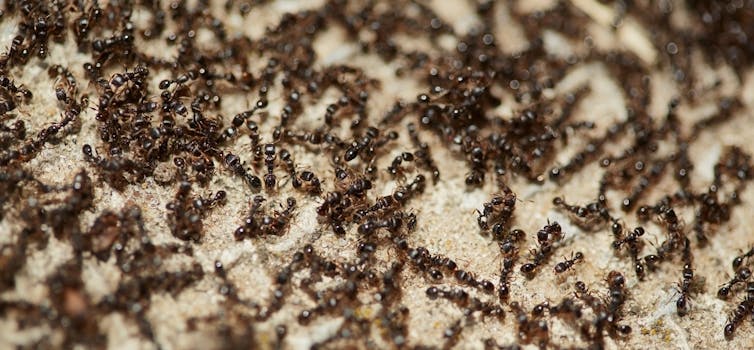
Have you ever wondered exactly how many ants live on Earth? Possibly not, but it’s certainly a question we’ve asked ourselves.
Our research published today provides an approximate answer. We conservatively estimate our planet harbours about 20 quadrillion ants. That’s 20 thousand million millions, or in numerical form, 20,000,000,000,000,000 (20 with 15 zeroes).
We further estimate the world’s ants collectively constitute about 12 million tonnes of dry carbon. This exceeds the mass of all the world’s wild birds and wild mammals combined. It’s also equal to about one-fifth of the total weight of humans.
Eminent biologist Edward O. Wilson once said insects and other invertebrates are “the little things that run the world” – and he was right. Ants, in particular, are a crucial part of nature. Among other roles, ants aerate the soil, disperse seeds, break down organic material, create habitat for other animals and form an important part of the food chain.
Estimating ant numbers and mass provides an important baseline from which to monitor ant populations amid worrying environmental changes.
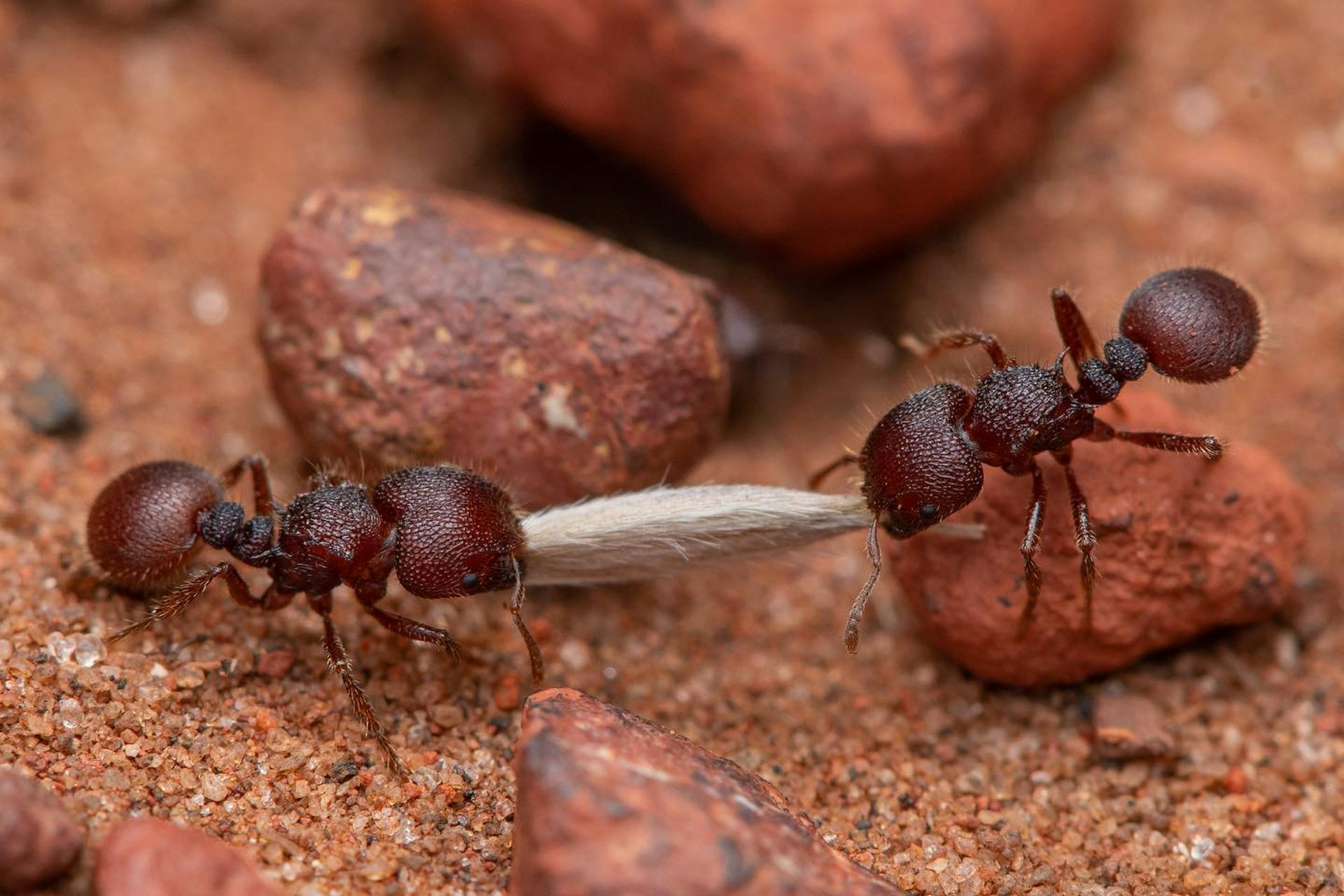
Counting the world’s ants
There are more than 15,700 named species and subspecies of ants, and many others not yet named by science. Ants’ high degree of social organisation has enabled them to colonise nearly all ecosystems and regions around the globe.
The astounding ubiquity of ants has prompted many naturalists to contemplate their exact number on Earth. But these were basically educated guesses. Systematic, evidence-based estimates have been lacking.
Our research involved an analysis of 489 studies of ant populations conducted by fellow ant scientists from around the world. This included non-English literature, in languages such as Spanish, French, German, Russian, Mandarin and Portuguese.
The research spanned all continents and major habitats including forests, deserts, grasslands and cities. They used standardised methods for collecting and counting ants such as pitfall traps and leaf litter samples. As you can imagine, this is often tedious work.
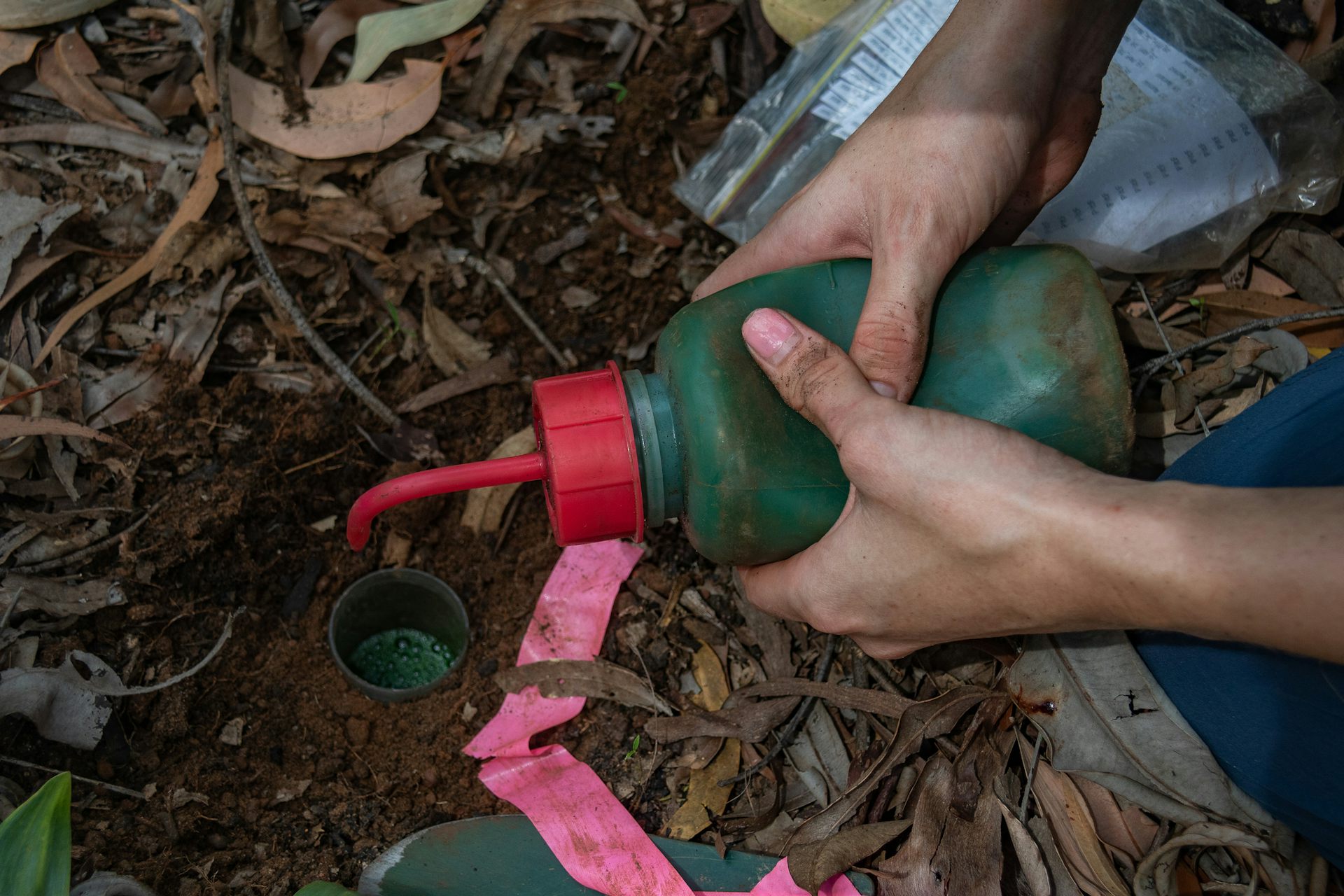
From all this, we estimate there are approximately 20 quadrillion ants on Earth. This figure, though conservative, is between two and 20 times higher than previous estimates.
The previous figures employed a “top-down” approach by assuming ants comprise about 1% of the world’s estimated insect population. In contrast, our “bottom-up” estimate is more reliable because it uses data on ants observed directly in the field and makes fewer assumptions.
Our next step was to work out how much all these ants weigh. The mass of organisms is typically measured in terms of their carbon makeup. We estimated that 20 quadrillion average-sized ants corresponds to a dry weight or “biomass” of approximately 12 million tonnes of carbon.
This is more than the combined biomass of wild birds and mammals – and about 20% of total human biomass.
Carbon makes up about half the dry weight of an ant. If the weight of other bodily elements was included, the total mass of the world’s ants would be higher still.
We also found ants are distributed unevenly on Earth’s surface. They vary sixfold between habitats and generally peak in the tropics. This underscores the importance of tropical regions in maintaining healthy ant populations.
Ants were also particularly abundant in forests, and surprisingly, in arid regions. But they become less common in human-made habitats.
Our findings come with a few caveats. For example, the sampling locations in our dataset are unevenly distributed across geographic regions. And the vast majority of samples were collected from the ground layer, meaning we have very little information about ant numbers in trees or underground. This means our findings are somewhat incomplete.
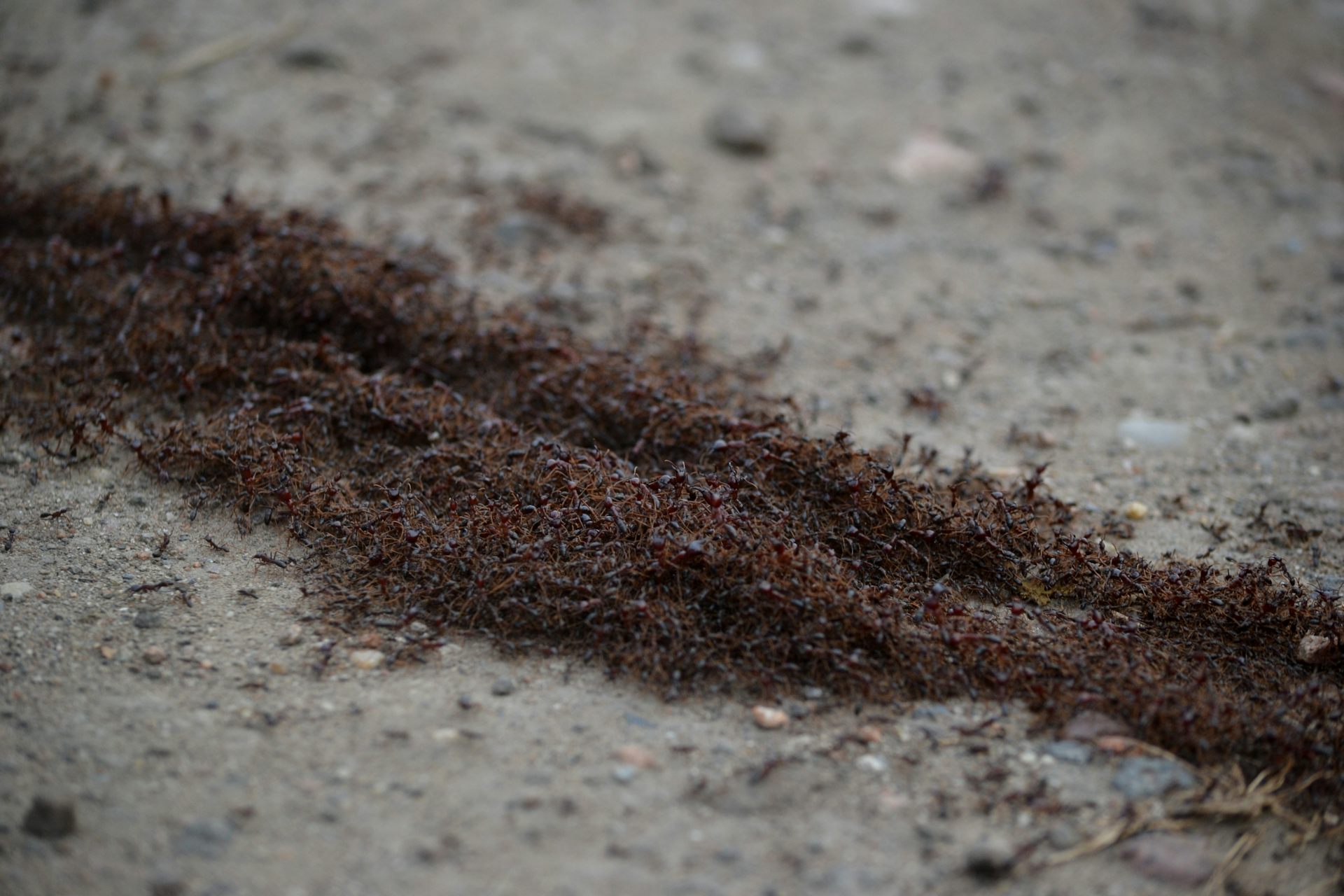
We all need ants
Ants also provide vital “ecosystem services” for humans. For instance, a recent study found ants can be more effective than pesticides at helping farmers produce food.
Ants have also developed tight interactions with other organisms – and some species cannot survive without them.
For example, some birds rely on ants to flush out their prey. And thousands of plant species either feed or house ants in exchange for protection, or dispersal of their seeds. And many ants are predators, helping to keep populations of other insects in check.
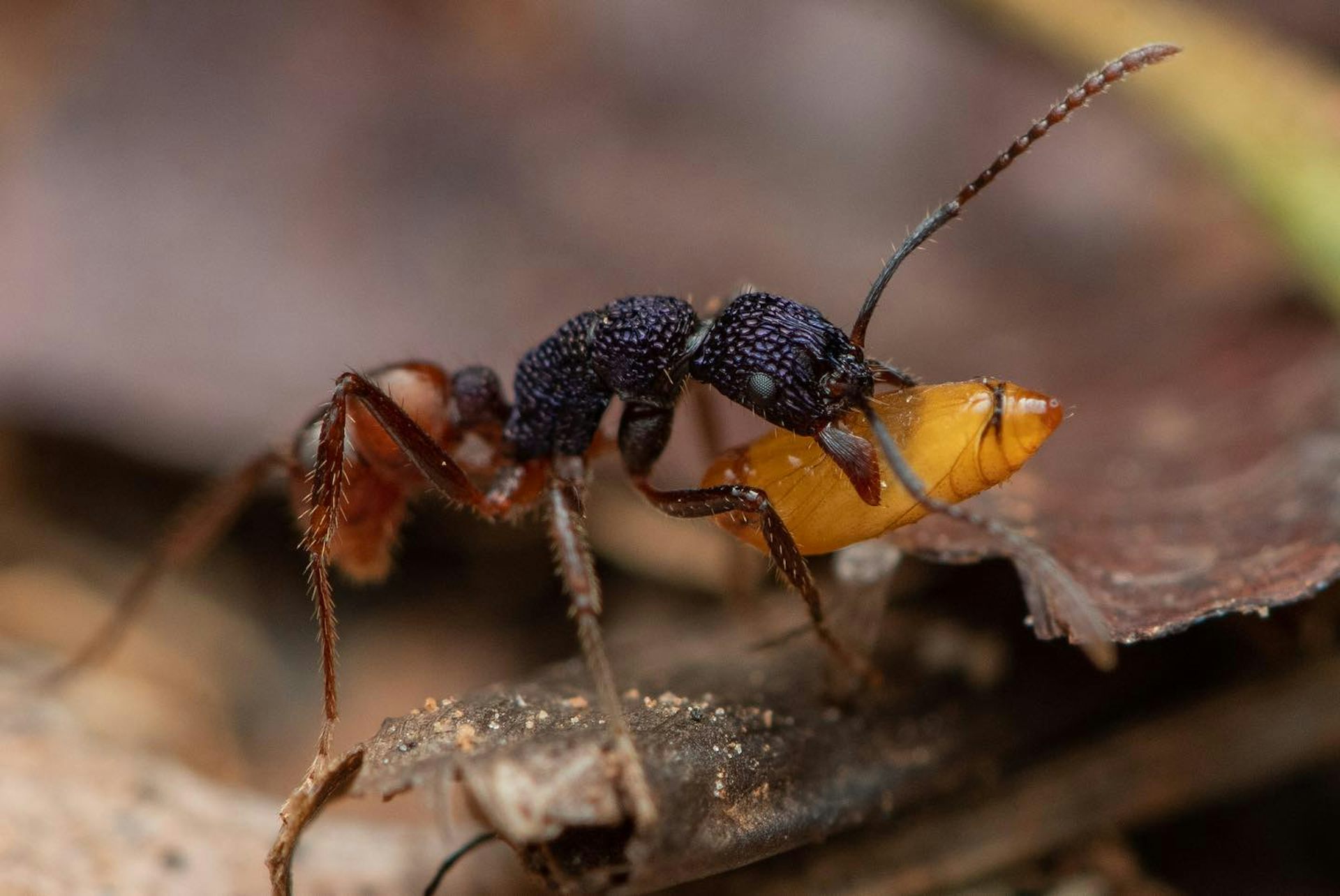
Alarmingly, global insect numbers are declining due to threats such as habitat destruction and fragmentation, chemical use, invasive species and climate change.
But data on insect biodiversity is alarmingly scarce. We hope our study provides a baseline for further research to help fill this gap.
It’s in humanity’s interest to monitor ant populations. Counting ants is not difficult, and citizen scientists from all over the world could help investigate how these important animals are faring at a time of great environmental change.
Benoit Guénard, Associate professor, University of Hong Kong;
François Brassard, PhD candidate, Charles Darwin University;
Patrick Schultheiss, Temporary Principal Investigator, Julius Maximilian University of Würzburg;
Runxi Wang, PhD candidate, University of Hong Kong,
and Sabine Nooten, Temporary Principal Investigator, Julius Maximilian University of Würzburg
SignificanceWith the exception of a few nasty ants such as the vicious bullet and fire ants, most species are harmless and even beneficial. In the UK we have the very common black garden ant that, when the conditions are right in Spring and Summer - the right humidity and a high pressure weather system to help with flying - have a nuptial flight when the winged unmated females and smaller males all take flight at the same time from several different nests in the area. The males pursue the female, and the winner gets to mate with her. He then dies, as do all the others who lost the race. The female lands, sheds her wings and looks for somewhere to build a nest and start a new colony. This gives rise to panic and complaints about an invasion of 'flying ants', and the hardware shops have a run on ant power. One very silly neighbour we once had used to spray ant powder along our adjoining fence because she believed all the ants in her garden had come from ours! People even pour boiling water on them!
The astounding ubiquity of ants has prompted many naturalists to contemplate their exact number on Earth, but systematic and empirically derived estimates are lacking. Integrating data from all continents and major biomes, we conservatively estimate 20 × 1015 (20 quadrillion) ants on Earth, with a total biomass of 12 megatons of dry carbon. This exceeds the combined biomass of wild birds and mammals and equals 20% of human biomass. Ant abundance is distributed unevenly on Earth, peaking in the tropics and varying sixfold among habitats. Our global map of ant abundance expands our understanding of the geography of ant diversity and provides a baseline for predicting ants’ responses to worrying environmental changes that currently impact insect biomass.
Abstract
Knowledge on the distribution and abundance of organisms is fundamental to understanding their roles within ecosystems and their ecological importance for other taxa. Such knowledge is currently lacking for insects, which have long been regarded as the “little things that run the world”. Even for ubiquitous insects, such as ants, which are of tremendous ecological significance, there is currently neither a reliable estimate of their total number on Earth nor of their abundance in particular biomes or habitats. We compile data on ground-dwelling and arboreal ants to obtain an empirical estimate of global ant abundance. Our analysis is based on 489 studies, spanning all continents, major biomes, and habitats. We conservatively estimate total abundance of ground-dwelling ants at over 3 × 1015 and estimate the number of all ants on Earth to be almost 20 × 1015 individuals. The latter corresponds to a biomass of ∼12 megatons of dry carbon. This exceeds the combined biomass of wild birds and mammals and is equivalent to ∼20% of human biomass. Abundances of ground-dwelling ants are strongly concentrated in tropical and subtropical regions but vary substantially across habitats. The density of leaf-litter ants is highest in forests, while the numbers of actively ground-foraging ants are highest in arid regions. This study highlights the central role ants play in terrestrial ecosystems but also major ecological and geographic gaps in our current knowledge. Our results provide a crucial baseline for exploring environmental drivers of ant-abundance patterns and for tracking the responses of insects to environmental change.
Schultheiss, Patrick; Nooten, Sabine S.; Wang, Runxi; Wong, Mark K. L.; Brassard, François; Guénard, Benoit
The abundance, biomass, and distribution of ants on Earth
Proceedings of the National Academy of Sciences (2022) 119(40); e2201550119; DOI: 10.1073/pnas.2201550119
Copyright: © 2022 The authors.
Published by PNAS
. Open access
Reprinted under a Creative Commons Attribution-NonCommercial-NoDerivatives License 4.0 (CC BY-NC-ND)
And yet these are harmless unless you annoy them then they can give a mild sting, more like a pinprick, really. They are incredibly useful in gardens where they account for thousands of caterpillars. Please treat them with respect. If they do come into your house, look upon them as cleaners because they'll be finding food crumbs and spilt sugar, etc. Keeping the floor and surfaces clean, and keeping food covered in sealed containers, will mean you won't get visits.
We need our ants - all 20 quadrillion of them!
Monday, 19 September 2022
Evolution News - How Our Gut Microbes Have Co-Evolved With Us.
When non-African humans came out of Africa, we didn't come alone. In addition to our ectoparasites such as lice, fleas, bedbugs, etc, we also brought some more fellow travellers. We brought our gut microbiota along with us.
And, like us, they have continued to evolve and diversify, co-evolving in lockstep with us, according to the findings by a group of researchers from the Max Planck Institute for Biology, Tübingen, Germany and several research institutes at the University of Tübingen, Germany. By constructing phylogenetic trees for both us and 59 species of microbes found in our gut biota, they showed that there is a close match between theirs and our trees. The more dependent the species of microbe is on us, the more closely our trees match.
This will shock Creationists, but they also found that the more dependent on us our microbes have become, the smaller their genomes. In other words, their evolution has been by loss of genetic information, similar to what we see in other obligate parasites such as parasitic worms. So close is the match for some microbes that it prompted one of the researchers to remark that they behave like part of the human genome.
According to the Max Planck Institute’s press release:
Sunday, 18 September 2022
Evolution News - Earliest Vertebrate Heart From 380 Million Years Ago.
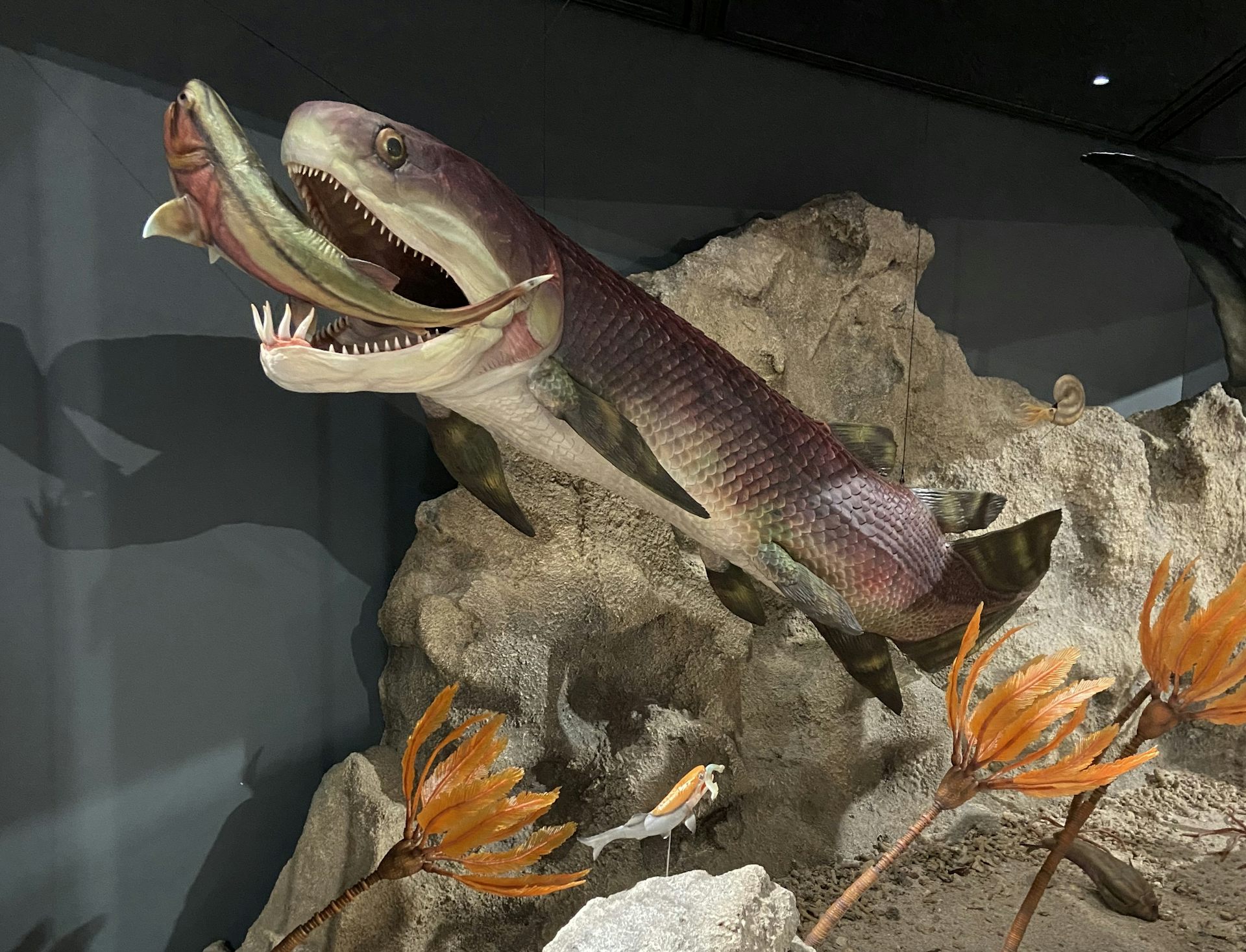
Although they probably don’t realise it, the function of the heart is as good evidence as it gets that the Bible wasn't written or inspired by the god described in it. No such omnipotent creator god would have assumed the heart was the seat of emotions when in fact it's simply a muscular pump for circulating blood around the body. Such silly mistakes are understandable if the Bible was written by ignorant people who lacked even basis science, of course, but not for any alleged creator of all life, including mammalian.
So, news that scientists have discovered the earliest fossil record of a mammalian heart from 380 million years ago, will come as a shock to Bible literalist creationists, if for no other reason than that it refutes the childish notion that the Universe was created by a creator god just a few thousand years ago, and the same creator created the human heart as the seat of emotion.
And Jesus answering saith unto them, Have faith in God. For verily I say unto you, That whosoever shall say unto this mountain, Be thou removed, and be thou cast into the sea; and shall not doubt in his heart, but shall believe that those things which he saith shall come to pass; he shall have whatsoever he saith.
Climate Emergency News - How Mangrove Swamps Capture Atmospheric Carbon
At the moment, we, and the planet we're floating in space on, need all the friends we can get, and few are more useful to us that the world's mangrove swamps. With humans releasing carbon into the atmosphere from fossils fuels as quickly as we can dig the stuff up or extract it from the geology, our friendly mangrove swamps are locking it back into the soil as quickly as they can bury the organic matter some of it is turned into. It can't count for all of it, of course, but every little helps.
And a team of scientists from the University of California Riverside (UCR) and the University of California San Diego (UCSD), have shown that it can stay locked up for 5,000 years, provided we keep the swamps alive and processing it. If not, it'll be released back into the atmosphere, with possibly catastrophic results.
Mangroves are higly specialised plants that can live and thrive in salt and brackish water subject to tidal changes, and with their roots in anoxic mud that would prevent most other plants from obtaining nutrients. Mangroves can quickly colonise these estuarine and coastal mudflats with a simple trick - their relatively large seed start to germinate and produce a long, pointed root while they are still attached to the parent plant. When they are released, they fall straight down to the soft mud and the root becomes embedded, in effect planting itself. It then produces the leaf-bearing stems which send down ariel roots, with air tubes like snorkels, into the mud to provide the oxygen the feeding roots need in the anoxic mud. The presence of these dense 'forests' of mangroves slows down the flow of water and causes more mud and floating plant matter to be deposited, so the swap deepens and extends over time, if left undisturbed. But it's what gets locked up in the mud that is the important thing from the point of view of Earth's carbon cycle. Because of the lack of oxygen, bacterial activity is low, giving rise to peat-like layers of plant matter, which decays at almost negligible rate.
The scientists have shown that the carbon locked up in this peat remains there for about 5000 years, as the University of California - Riverside news release explains:
The team expected that carbon would be found in the layer of peat beneath the forest, but they did not expect that carbon to be 5,000 years old. This result, along with a description of the microbes they identified, is now published in the journal Marine Ecology Progress Series.The abstract to the team's open access paper in the journal Marine Ecology Progress Series, gives more technical details:Peat underlying the mangrove trees is a combination of submerged sediment and partially decayed organic matter. In some areas sampled for this study, the peat layer extended roughly 10 feet below the coastal water line.What’s special about these mangrove sites isn’t that they’re the fastest at carbon storage, but that they have kept the carbon for so long. It is orders of magnitude more carbon storage than most other ecosystems in the region.
Emma Aronson, senior co-author
Environmental microbiologist
University of California Riverside,
Riverside, California, USA
Little oxygen makes it to the deepest peat layer, which is likely why the team did not find any fungi living in it; normally fungi are found in nearly every environment on Earth. However, oxygen is a requirement for most fungi that specialize in breaking down carbon compounds. The team may explore the absence of fungi further in future mangrove peat studies.
There are more than 1,100 types of bacteria living beneath the mangroves that consume and excrete a variety of chemical elements. Many of them function in extreme environments with low or no oxygen. However, these bacteria are not efficient at breaking down carbon.
These sites are protecting carbon that has been there for millennia. Disturbing them would cause a carbon emission that we wouldn’t be able to repair any time soon.
If we let these forests keep functioning, they can retain the carbon they’ve sequestered out of our atmosphere, essentially permanently. These mangroves have an important role in mitigating climate change.
Matthew Costa, first author
Coastal ecologist
University of California San Diego
San Diego, California, USA.There are other ecosystems on Earth known to have similarly aged or even older carbon. Arctic or Antarctic permafrost, where the ice hasn’t yet thawed allowing a release of gases, are examples. Potentially, other mangrove forests as well. The researchers are now scouting mangrove research sites in Hawaii, Florida and Mexico’s Yucatan Peninsula as well.The deeper you go into the peat soils, the fewer microorganisms you find. Not much can break down the carbon down there, or the peat itself, for that matter. Because it persists for so long, it’s not easy to make more of it or replicate the communities of microbes within it.
Mia Maltz, co-author
Microbial ecologist
University of California Riverside,
Riverside, California, USA
Carbon dioxide increases the greenhouse effect that is causing the planet to heat up. Costa believes that one way to keep this issue from worsening is to leave mangroves undisturbed.
ABSTRACT: Mangroves provide important ecosystem services, including storing carbon belowground for millennia. Mangrove carbon storage relies in part on high primary productivity, but essential to the long-lived nature of this storage is the slow rate of microbial decomposition of peat. In this study, we (1) examined how carbon and nitrogen densities and microbial community composition vary with peat age and (2) describe the formation of peat deposits over time. At 4 mangrove sites near La Paz, Baja California Sur, Mexico, we cored the sediments until rejection and obtained 5 cm samples at 20 cm intervals. In these samples, we measured organic carbon (Corg), total nitrogen, δ13C, δ15N, and radiocarbon (14C) age. We observed peat carbon densities of 3.4 × 10-2 ± 0.2 × 10-2 g cm-3, Corg:N ratios of 42 ± 3, and inter-site variation in Corg:N that reflects differing preservation conditions. Recalcitrant organic matter sources and anaerobic conditions leave a strong imprint on peat microbial communities. Microbial community composition and diversity were driven by depth and sediment characteristics, including Corg:N ratio and 14C age. Carbon dating allowed us to reconstruct the accumulation of organic matter over the last 5029 ± 85 yr. Even over this long time scale, though microbes have evidently continuously cycled the peat nitrogen pool, peat carbon density remains effectively unchanged.Although mangrove forests alone can't solve the mess we've made of the planet, they help, and destroying them would be catastrophic, so we have to do all we can to protect and encourage them, as though our lives depend on it, because they do, and so do the lives of our children, grandchildren and future generations.
Costa MT, Ezcurra E, Aburto-Oropeza O, Maltz M, Arogyaswamy K, Botthoff J, Aronson E (2022)
Baja California Sur mangrove deep peat microbial communities cycle nitrogen but do not affect old carbon pool.
Mar Ecol Prog Ser 695:15-31. DOI: 10.3354/meps14117
Copyright: © 2022 The authors. Published by Inter-Research Science Publishers. Open access
Reprinted under a Creative Commons Attribution 4.0 International license (CC BY 4.0)
Antivaxx Covidiot News - Another Good Reason to Get Vaccinated
My last booster was in March this year, so I would be interested to know what level of protection I now have because, as this study shows, the antibody level falls over time, particularly for people like me who have stayed infection free, so that for 36% of people who were vaccinated but never got infected, their antibody level is undetectable after a year! This means, if I wait till Spring, I'll go through most of the coming Winter with a low antibody count.
If any more evidence were needed that vaccination against COVI-19 is essential, even for people who have had the disease and acquired some natural protection, this study, by an international team led by Marianna Karachaliou, Gemma Moncunill, Manolis Kogevinas and Carlota Dobaño and colleagues provides it. The main findings, published open access in MBC Medicine, include:
Friday, 16 September 2022
Climate Emergency News - How to Convince the Loonies
Inside the mind of a sceptic: the ‘mental gymnastics’ of climate change denial
How do you convince the climate change denying loonies to believe the evidence of their own eyes?
It's about as hard as convincing a Creationist that evidence-based science is right and evidence-free superstitions is wrong, as this article in The Conversation by Rachael Sharman, Senior Lecturer in Psychology, and Professor Patrick D. Nunn, Professor of Geography, School of Law and Society, both of the University of the Sunshine Coast, Queensland, Australia, explains. It is about their research into the causes of climate scepticism in Australia, but the findings have a wider application, especially in the USA where scepticism is high, following the scientifically illiterate Donald Trump's lead, and the pro-Trump, QAnon conspiracy theorists' disinformation campaign.
Their article is reprinted under a Creative Commons license, reformatted for stylistic consistency. The original article can be read here.
Wednesday, 14 September 2022
Creationism In Crisis - Scientists Find Evidence of Domesticated Animals From Thousands of Years Before God Allegedly Created Them

A paper published today in PLoS One, will make grim reading for anyone still trying to cling to the discredited notion of Bible inerrancy in matters of science and history, because it shows that humans had domesticated cattle at least before 12,300 years ago., i.e. 8,000 years before Bible literalists believe Earth was created.
The evidence was found by Alexia Smith of the Department of Anthropology, University of Connecticut, U.S.A, and colleagues, in the shape of crystals of dung spherulites — tiny calcium carbonate clumps found in the dung of animals - at Abu Hureyra, Syria, at a site which had been occupied for several thousand years, spanning the transition of human culture from hunter-gatherers to farming and cattle herding.
It is also evidence of that transition because those who kept these small herd of animals, probably mostly sheep, were still hunter-gatherers, so this marks the beginning of cattle herding in the area.
PLoS describe the finding and its significance in information released ahead of publication:
Monday, 12 September 2022
Climate Emergency News - Earth is in Imminent Danger as Climate Tipping Points are Reached

14. The Meaning of Life
You are the end-point of your own genes' evolution. You are the descendant of survivors, each of whom bred successfully and never once failed – for 3.5 billion years! Think about that for a moment. In a world in which, for very many individuals, an early death and failure to breed were by far the most likely outcome, not one single one of your ancestors failed to produce at least one offspring. If they had failed, your gene-line would have ended there and then. You are the product of billions of passes through the sieve of selection and at every pass your gene-line passed the fitness test. Your genes are good at surviving; and you are unique in the history of the cosmos. The likelihood of you being alive at all is almost vanishingly small and yet here you are. Never before has anyone with your combination of genes, your collection of atoms and your history existed.
And you never will again.
Almost all your genes have spent much longer being something else than they have being human. Your ancestors were there when Europe and Africa split off from the Americas. They were there as small mammal-like reptiles when dinosaurs ruled the earth. They saw pterodactyls flying overhead. They survived the mass-extinction which ended the dinosaurs’ reign and they saw the birds and the bats grow wings and take to the air.
Your ancestors swam in the Cambrian seas and crawled out onto the land as early air-gulping fish destined to become four–legged animals with lungs. Your ancestors lived through the Carboniferous era when dense forests of tree ferns grew in steaming jungles where dragonflies with meter-wide wings flew. They saw the trees fall and form the piles of vegetation destined to be coal as the climate changed and the Carboniferous forests collapsed. They saw the first flowering plants as plants and insects formed their mutual-benefit society.
Covidiot News - More Success For the Pro-Trump Covidiot Self Genocide Campaign
News of the continuing success for the pro-Trump Repugnicans in their effort to minimise the seriousness of the COVID-19 pandemic to try to cover up Donald Trump's incompetent handling of the crisis when president, comes in the form of a Gallop poll, showing the much lower level of concern about COVID19 exposure at work by Republican voters compared to Democrat voters.
Although overall concern remains fairly high at 33%, there is a wide difference between Democrat and Republican voters. While 51% of Democrat voters were very or moderately concerned, only 14% of Republican votes were, and while only 19% of Democrats were not concerned at all, this figure rose to 61% for Republicans.
Quite obviously, there is a significant risk of contracting the virus when working in close proximity with others and for those without the protection of a vaccination or whose antibody level may have fallen to a low level and in need of boosting.

